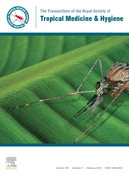-
Views
-
Cite
Cite
Martha Betson, Peter Nejsum, Julia Llewellyn-Hughes, Claire Griffin, Aaron Atuhaire, Moses Arinaitwe, Moses Adriko, Andrew Ruggiana, Grace Turyakira, Narcis B. Kabatereine, J. Russell Stothard, Genetic diversity of Ascaris in southwestern Uganda, Transactions of The Royal Society of Tropical Medicine and Hygiene, Volume 106, Issue 2, February 2012, Pages 75–83, https://doi.org/10.1016/j.trstmh.2011.10.011
Close - Share Icon Share
Abstract
Despite the common occurrence of ascariasis in southwestern Uganda, helminth control in the region has been limited. To gain further insights into the genetic diversity of Ascaris in this area, a parasitological survey in mothers (n = 41) and children (n = 74) living in two villages, Habutobere and Musezero, was carried out. Adult Ascaris worms were collected from infected individuals by chemo-expulsion using pyrantel pamoate treatment. Genetic diversity within these worms was assessed by inspection of DNA sequence variation in a mitochondrial marker and length polymorphism at microsatellite loci. Overall prevalence of ascariasis was 42.5% in mothers and 30.4% in their children and a total of 98 worms was examined from 18 hosts. Sequence analysis of a portion of the mitochondrial cytochrome c oxidase subunit 1 gene revealed 19 different haplotypes, 13 of which had not been previously encountered. Microsatellite analysis using eight loci provided evidence for high gene flow between worm populations from the two villages but comparing these worms with others obtained in a prior study on Unguja, Zanzibar, confirmed little genetic exchange and mixing of worm populations between the two areas. By adding to our understanding of the genetic diversity of Ascaris in Africa, this study provides useful information for monitoring changes in parasite population structure in the face of ongoing and future control.






Comments